NVR Bundle
Who Really Controls NVR Inc.?
Understanding NVR SWOT Analysis is crucial, but have you ever wondered who truly steers the ship at NVR Company? The ownership structure of NVR, a major player in the real estate market with brands like Ryan Homes, directly impacts its strategic decisions and long-term success. From its inception to its current market position, the evolution of NVR's ownership reveals fascinating insights into its corporate governance and future trajectory.
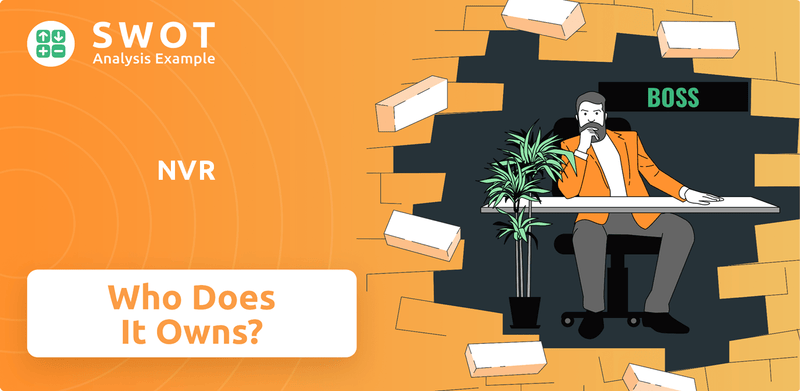
This exploration into NVR Company Ownership will uncover the influence of major shareholders, the roles of NVR executives, and the composition of the NVR company board of directors. We'll examine how factors like NVR stock performance and the company's market capitalization shape its ownership profile. Whether you're curious about how to buy NVR stock or interested in the NVR company investor relations, this analysis provides a comprehensive view of who owns NVR and how it impacts the company's direction.
Who Founded NVR?
The story of NVR, Inc. begins in 1980 with its founder, Dwight C. Schar. He established the company, initially known as NVHomes, with a vision to become a leading homebuilder. The early ownership structure was largely centered around Schar, who served as Chairman and CEO for many years, shaping the company's direction from the start.
While specific details on the initial equity split or early investors are not widely available in public records, it's clear that Schar was the driving force behind NVR's inception. His leadership was crucial in navigating the early stages of the company and setting the foundation for its future growth in the real estate market. This concentrated ownership allowed for streamlined decision-making, which was particularly beneficial during the company's early expansion phase.
The initial focus of NVHomes was to establish a strong presence in the Mid-Atlantic region, a goal driven by Schar's vision. The company's early success was a testament to the founder's strategic direction and hands-on approach to building homes and establishing a solid business model. The centralized control structure under Schar facilitated quick responses to market opportunities and challenges.
Dwight C. Schar founded NVR, Inc. in 1980.
The company was initially known as NVHomes.
Primarily centered around Schar.
To become a leading homebuilder in the Mid-Atlantic region.
Details of early backers or angel investors are not widely documented.
Centralized control structure, allowing for rapid decision-making.
Understanding the early ownership of NVR, Inc. is crucial for investors and those interested in the company's history. The initial structure, with Dwight C. Schar at the helm, facilitated the company's growth. For a deeper dive into the company's business model, see Revenue Streams & Business Model of NVR.
- Dwight C. Schar founded NVR in 1980 and was the primary owner in the early years.
- The company's early focus was on becoming a leading homebuilder in the Mid-Atlantic region.
- The centralized control under Schar allowed for quick decision-making and expansion.
- Details on early investors are not widely available in public records.
NVR SWOT Analysis
- Complete SWOT Breakdown
- Fully Customizable
- Editable in Excel & Word
- Professional Formatting
- Investor-Ready Format
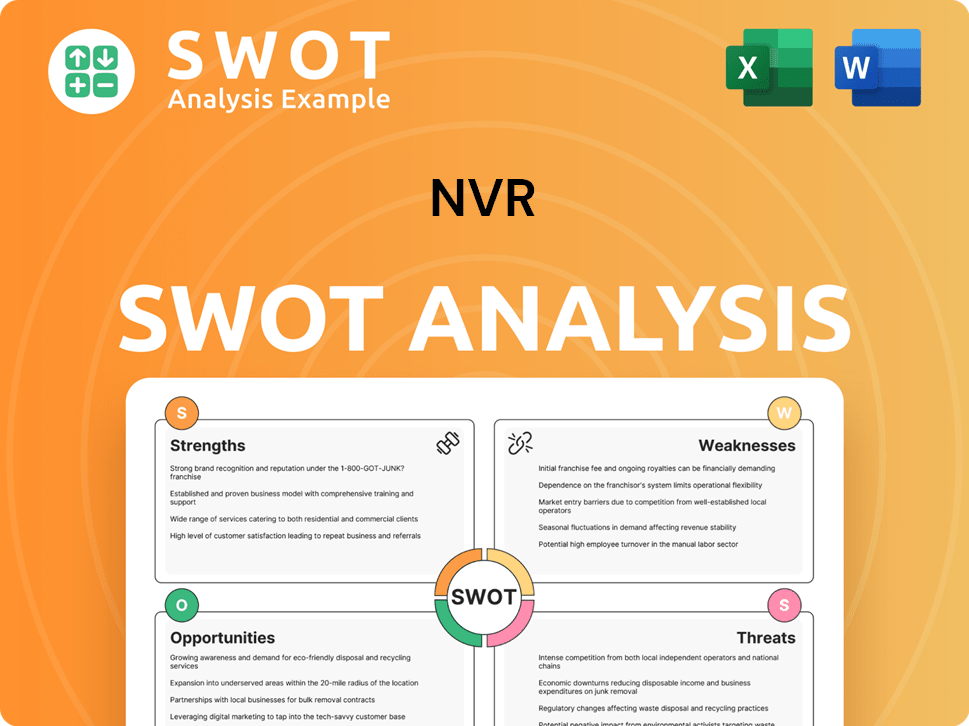
How Has NVR’s Ownership Changed Over Time?
The journey of NVR Company Ownership began on November 13, 1986, when it went public through an Initial Public Offering (IPO). This event marked a pivotal shift from private to public ownership, opening the doors for a broader range of investors. Over time, the ownership structure of NVR has evolved, primarily due to the increasing influence of institutional investors, reflecting the company's growth and integration into the broader financial markets. The shift towards institutional ownership is a common trend for established public companies, as they often attract significant investment from large asset managers and funds.
The evolution of Who owns NVR has been influenced by various factors, including market dynamics, the company's performance, and strategic decisions. The founder, Dwight C. Schar, initially held a significant stake, but as the company expanded and issued more shares, his ownership, along with that of other early insiders, naturally diluted. This dilution is a typical outcome in the growth trajectory of a public company. Changes in major shareholding can also be attributed to shifts in investment strategies by large funds or rebalancing of portfolios, which can subtly influence company strategy, particularly regarding capital allocation, share buybacks, and dividend policies.
| Event | Impact on Ownership | Date |
|---|---|---|
| Initial Public Offering (IPO) | Transition from private to public ownership, enabling broader investor participation. | November 13, 1986 |
| Secondary Share Offerings | Dilution of existing shareholders' stakes, increased public float. | Ongoing |
| Institutional Investment | Increased influence of large asset managers and funds on company strategy. | Ongoing |
| Founder's Stake Dilution | Gradual decrease in founder's ownership percentage due to share issuances. | Ongoing |
As of early 2025, the major stakeholders in NVR Inc. include prominent institutional investors. Vanguard Group, Inc. holds approximately 11.85% of NVR's shares, while BlackRock Inc. holds around 8.12%. State Street Corp. is also among the top institutional holders. These institutional investors collectively hold a substantial portion of NVR's outstanding shares. Understanding the ownership structure is crucial for investors and stakeholders. For more insights into the company's strategic direction, consider reading about the Growth Strategy of NVR.
The ownership of NVR has evolved significantly since its IPO in 1986, with a shift towards institutional investors.
- Institutional investors like Vanguard and BlackRock hold significant stakes.
- The founder's ownership has diluted over time.
- Changes in ownership can influence company strategy, especially regarding financial decisions.
- Understanding the ownership structure is vital for stakeholders.
NVR PESTLE Analysis
- Covers All 6 PESTLE Categories
- No Research Needed – Save Hours of Work
- Built by Experts, Trusted by Consultants
- Instant Download, Ready to Use
- 100% Editable, Fully Customizable
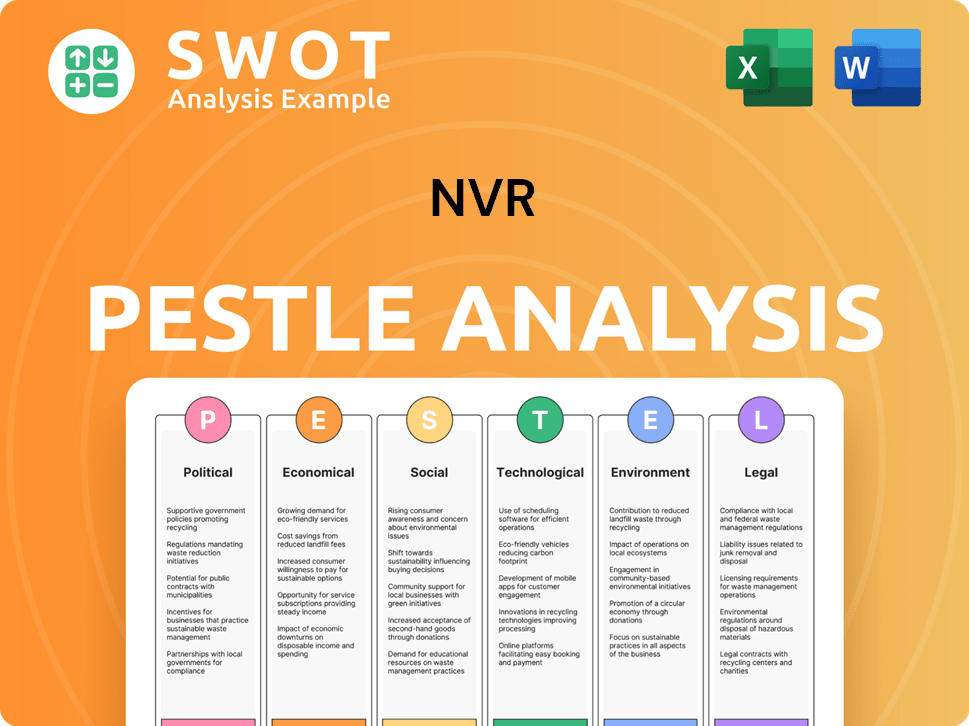
Who Sits on NVR’s Board?
The Board of Directors of NVR, Inc. is essential to the company's governance and its relationship to ownership. As of early 2025, the board includes a mix of independent directors and those with historical ties to the company. To find the full list of current board members and their specific affiliations to major shareholders, one would need to consult the latest proxy statements.
Publicly traded companies like NVR often have a majority of independent directors to ensure objective oversight. This structure helps maintain a balance between the interests of the company and its shareholders. The composition of the board is crucial for making decisions that align with the long-term interests of all shareholders.
| Board Member | Title | Affiliation |
|---|---|---|
| Paul Saville | Chairman of the Board | Independent Director |
| Dwight C. Schar | Director | Founder |
| Robert J. Taubman | Lead Independent Director | Independent Director |
NVR's voting structure typically operates on a one-share-one-vote basis for its common stock. Each share of common stock entitles the holder to one vote on matters submitted to a vote of shareholders. There are no publicly reported dual-class shares or special voting rights that grant disproportionate control to specific individuals or entities. The stability of the board and the voting structure are key factors in understanding the company's ownership dynamics. For more insights into the company's strategy, consider reading about the Target Market of NVR.
Understanding who owns NVR, Inc. is crucial for investors and stakeholders. The board of directors plays a vital role in governance, with a mix of independent and affiliated members. The voting structure is straightforward, with one share typically equaling one vote.
- Board composition includes independent directors.
- Voting rights are generally one-share-one-vote.
- No dual-class shares are publicly reported.
- The stability of the board is key.
NVR Business Model Canvas
- Complete 9-Block Business Model Canvas
- Effortlessly Communicate Your Business Strategy
- Investor-Ready BMC Format
- 100% Editable and Customizable
- Clear and Structured Layout
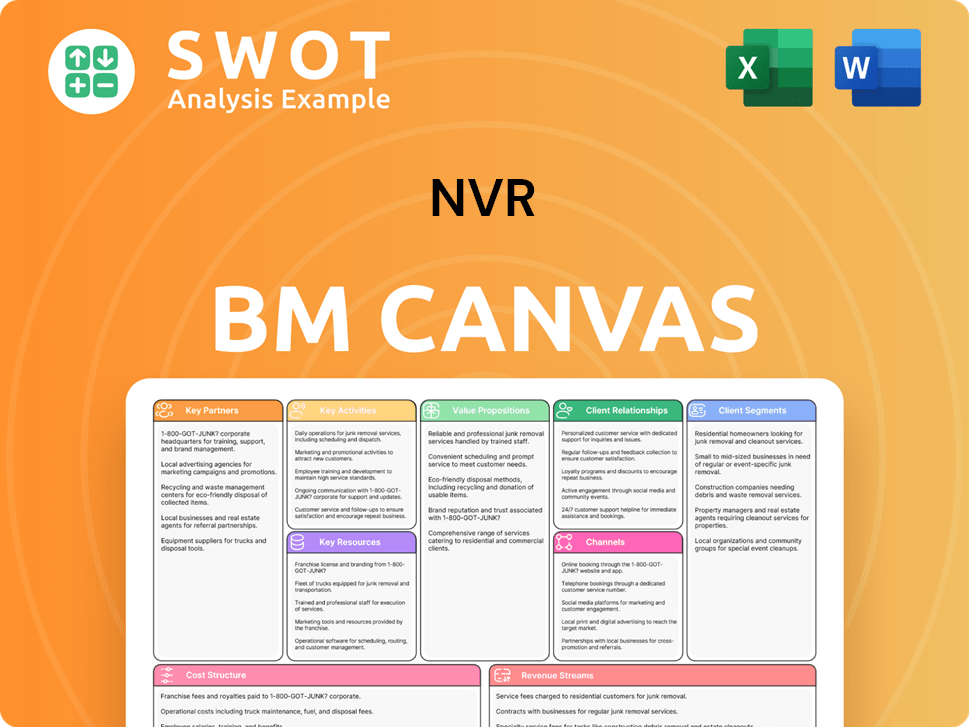
What Recent Changes Have Shaped NVR’s Ownership Landscape?
Over the past few years, the ownership structure of NVR, Inc. has largely remained stable, with a strong presence of institutional investors. This stability reflects the company's solid performance in the homebuilding sector. Marketing Strategy of NVR has played a role in maintaining investor confidence. The company has focused on returning value to shareholders through share buybacks, a common practice among profitable, mature companies. This strategy can potentially reduce the number of outstanding shares, thereby increasing earnings per share.
Industry trends indicate that homebuilders often see increased institutional ownership due to the sector's cyclical nature. NVR's consistent performance has helped retain institutional investors. As of April 2025, the company's market capitalization is approximately $23.77 billion, making it an attractive holding for a diverse range of institutional investors. There have been no major shifts in leadership or significant changes in the ownership structure that would drastically alter its current public ownership model.
| Key Ownership Trends | Details | Impact |
|---|---|---|
| Institutional Ownership | Dominant, reflecting sector stability and company performance. | Provides stability and confidence in the company's long-term prospects. |
| Share Buybacks | Ongoing practice to return value to shareholders. | Reduces outstanding shares, potentially increasing earnings per share. |
| Founder Dilution | Natural progression for successful public companies. | Reflects company growth and expansion. |
The current ownership structure of NVR, Inc. is characterized by its stability and the continued interest of institutional investors. This stability is supported by the company's financial health and strategic decisions, such as share buybacks, aimed at maximizing shareholder value. The absence of major ownership changes suggests a continuation of the current public ownership model.
NVR stock has demonstrated consistent performance, attracting institutional investors. Its market capitalization as of April 2025 is approximately $23.77 billion. This performance reflects the company’s strong position in the homebuilding sector and its effective financial strategies.
The ownership structure of NVR is dominated by institutional investors, indicating confidence in the company's long-term prospects. Share buybacks are a key strategy used to return value to shareholders. Founder dilution is a natural progression for successful public companies.
Key executives play a crucial role in the company's performance and strategic direction. Their decisions impact the company's market position and investor confidence. The leadership team's stability contributes to the company's consistent performance.
NVR's financial health is strong, supported by its market capitalization and strategic financial moves. The company's ability to generate consistent revenue and earnings makes it an attractive investment. Financial reports offer insights into the company's performance.
NVR Porter's Five Forces Analysis
- Covers All 5 Competitive Forces in Detail
- Structured for Consultants, Students, and Founders
- 100% Editable in Microsoft Word & Excel
- Instant Digital Download – Use Immediately
- Compatible with Mac & PC – Fully Unlocked
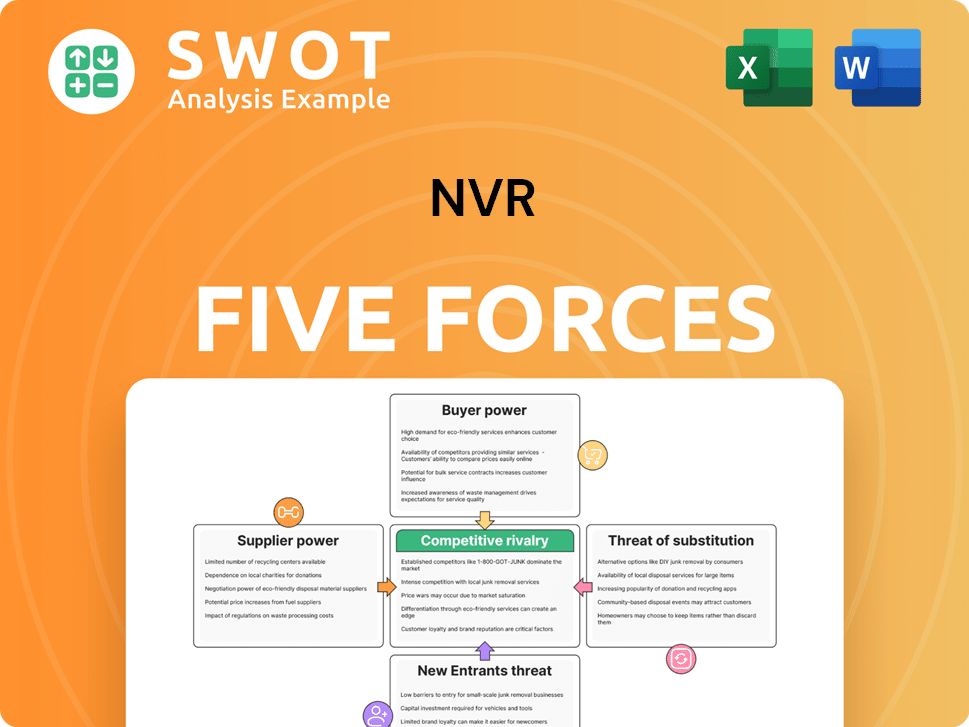
Related Blogs
- What are Mission Vision & Core Values of NVR Company?
- What is Competitive Landscape of NVR Company?
- What is Growth Strategy and Future Prospects of NVR Company?
- How Does NVR Company Work?
- What is Sales and Marketing Strategy of NVR Company?
- What is Brief History of NVR Company?
- What is Customer Demographics and Target Market of NVR Company?
Disclaimer
All information, articles, and product details provided on this website are for general informational and educational purposes only. We do not claim any ownership over, nor do we intend to infringe upon, any trademarks, copyrights, logos, brand names, or other intellectual property mentioned or depicted on this site. Such intellectual property remains the property of its respective owners, and any references here are made solely for identification or informational purposes, without implying any affiliation, endorsement, or partnership.
We make no representations or warranties, express or implied, regarding the accuracy, completeness, or suitability of any content or products presented. Nothing on this website should be construed as legal, tax, investment, financial, medical, or other professional advice. In addition, no part of this site—including articles or product references—constitutes a solicitation, recommendation, endorsement, advertisement, or offer to buy or sell any securities, franchises, or other financial instruments, particularly in jurisdictions where such activity would be unlawful.
All content is of a general nature and may not address the specific circumstances of any individual or entity. It is not a substitute for professional advice or services. Any actions you take based on the information provided here are strictly at your own risk. You accept full responsibility for any decisions or outcomes arising from your use of this website and agree to release us from any liability in connection with your use of, or reliance upon, the content or products found herein.